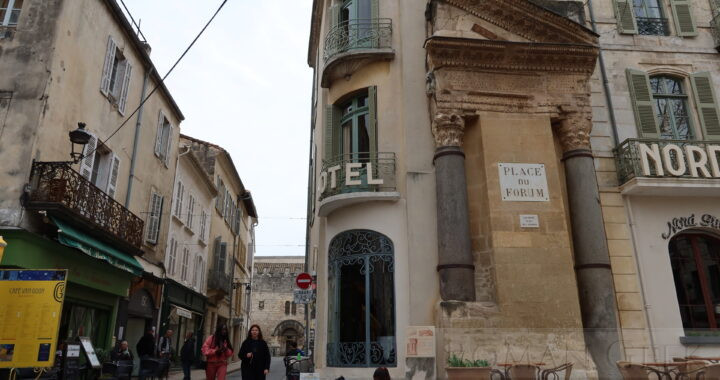- Arles is a cathedral city located on the river Rhone in the Provence-Alpes-Cotes d’Azur Region of southeastern France. Arles has the greatest concentration of Roman Monuments of any French city in France and was listed as a UNESCO World Heritage Site in 1981.
- It was known to the Romans as Arelate and was located in the Province of Gallia Narbonensis. It was a strategic city with a permanent pontoon bridge made of anchored vessels moored across the Rhone.
Camargue
- Below Arles, the river Rhone divides into two arms, Le Grand Rhone and Le Petit Rhone.
- Between its two arms lies a Wilderness known as the Camargue. This is the Rhone Delta which fans out to the sea.
- It is a unique wetland of lakes and marshes which is home to Camargue horses and cattle, Pink Flamingos and over 400 species of birds.
History
- In 104 BCE, Marius arrived with 5 Legions and made a camp in the area adjacent to Arles whilst waiting to confront the Cimbri and the Teutones. He built the Fossa Mariana (no longer extant) between Arles and the sea in order to get supplies past the turbulent Rhone delta.
- Then in 103 BCE he defeated the Teutones and Ambrones at the Battle of Aquae Sextiae, saving Italy from the threat of invasion.
- In 49 BCE, during the Great Roman Civil War (49-45 BCE), Julius Caesar awarded Arles the territories of Marseille, after its defeat during the Siege of Massilia.
- Arles was later used as a base for forward military operations by Emperors and Usurpers in the Late Roman Empire (284-476 CE).
- It is famous for the Arles Roman Amphitheatre which is still intact.
- Constantine I (307-337 CE) built the Baths and his son, Constantine II (337-340 CE) was born in Arles.
Roman Sites
- Arles Roman Amphitheatre (c.90 CE)
- The Amphitheatre can be visited and still hosts performances during the Summer.
- Arles Roman Theatre (c. 12 BCE)
- This monument can be visited.
- Baths of Constantine (307-337 CE)
- This monument can be visited.
- Hippodrome (149 CE)
- The Circus could seat 20,000 spectators. A small vestige of the Roman Circus is visible in front of the Museum of Antiquities.
- Les Alyscamps
- This Roman Cemetery still has many stone sarcophagii lining the old Roman Road out of Arles. It is adjacent to the more recent Canal de Craponne which opened in 1585.
- Cryptoporticus
- Located under the Hotel de Ville in the Place de la Republique, it is an underground vaulted cave system which served to support the Forum.
- Arles City Walls and the Gate of Augustus
- The Roman Walls are still in situ and can be seen along the Boulevard Emile Combes.
- The twin semi-circular bastions of the Gate of Augustus are located between the Tour des Mourgues and the Church of Notre-Dame-de-la-Major. The Boulevard Emile Combes was excavated in the 18th century, leaving the Roman wall and gate suspended up above.
- Obelisk
- It is now located in front of the Hotel de Ville in the Place de la Republique. It has no inscription.
- The Obelisk was installed by Constantine II (317-340 CE) as the Spina in the Roman Circus. The granite came from Asia Minor.
Museums
- Arles Museum of Antiquities
- Located at the Presqu’ile du Cirque Romain, Arles, the Museum holds Roman artefacts found in the area including:
- A model of the overshot water mills of Barbegal.
- A model of the Pontoon Bridge over the Rhone.
- Stone Sarcophagii from the Alyscamps with their carvings and inscriptions intact.
- Roman Ingots of Lead, Copper and Tin.
- ‘Arles Rhone 3’:
- A unique vessel found buried in the mud of the riverbank at Arles.
- It is a 1st century CE flat bottomed Roman river cargo boat, a sort of giant punt, which was found intact with its steering oar, towing mast, pulleys, anchors and a cargo of stones.
- It was 102 feet (31m) long, 10 feet (3m) wide and 3 feet (1m) deep. The towing rope was threaded through the Bow section which was pointed.
- Located at the Presqu’ile du Cirque Romain, Arles, the Museum holds Roman artefacts found in the area including:
- Museon Arlaten
- Located in Rue de la Republique, the courtyard of the museum holds part of the Roman Forum, with vestiges of the street, pavements and columns.
Roman Roads
- Via Agrippa
- Via Antonina
- A parallel road to the Via Agrippa
- A Roman Pontoon Bridge existed which carried the Via Antonina across the Rhone, but no trace remains today.
Nearby Sites
- Barbegal
- A Siphon Aqueduct and water mill on the downhill section which had 16 wheels.
Photo and map: Hidden in plain sight – Vestige of a Roman Temple in the Place du Forum, Arles

